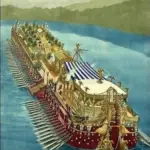A groundbreaking infrastructure project is underway: an 11-mile underwater tunnel connecting Denmark and Germany, expected to open in 2029. This monumental £5.5 billion development, inaugurated by Denmark’s King Frederik in June, will link the Danish town of Rödbyhavn to the German port of Puttgarden. It is poised to become the world’s longest underwater route accommodating both road and train traffic.

Key Features of the Tunnel
- Length and Structure: The tunnel spans 11 miles (18 kilometers) and features five separate passages: two for rail tracks, two for roads, and one service tunnel.
- Construction Process: Massive concrete elements, each 217 meters long, are built at a custom site in Rödbyhavn. Once sealed and floated to position, they are submerged with millimeter precision and connected.
- Travel Efficiency: The tunnel will significantly cut travel times—just 10 minutes by car and 7 minutes by train.
Global Infrastructure Significance
This project will be a transformative addition to Europe’s transportation network, especially for the Nordic region. The Fehmarnbelt tunnel, along with the Öresund Bridge connecting Copenhagen to Malmö, Sweden, will streamline road and rail traffic between Central and Northern Europe. It is expected to boost cargo transport and tourism, making regions like the Arctic Lapland more accessible.
Comparative Scale
While the Fehmarnbelt tunnel sets a record for dual-purpose underwater tunnels, it ranks behind the Channel Tunnel (23.6 miles) and Japan’s Seikan Tunnel (14.5 miles) in overall length, which are exclusively for road traffic.
Economic and Social Impact
This ambitious infrastructure project is set to bolster regional economies by improving connectivity, reducing travel times, and encouraging tourism. Enhanced transportation links are expected to attract more visitors to scenic Nordic destinations and facilitate smoother movement of goods across Europe.
With construction advancing steadily, the Fehmarnbelt tunnel promises to redefine travel and logistics in Europe by 2029.
4o






















